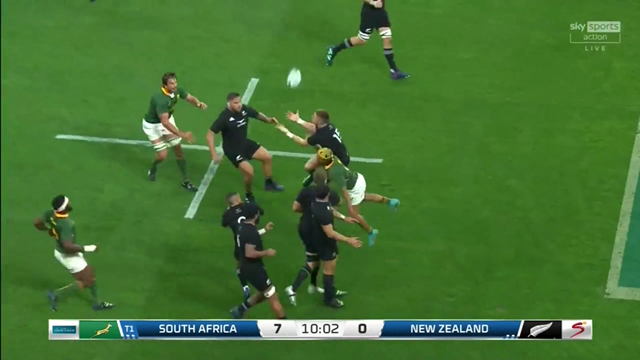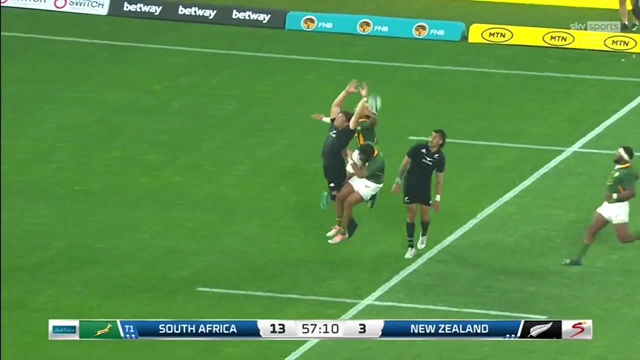Rugby teams all have areas of preference, aspects of the game they will attack particularly hard because it suits their outlook and philosophy there. It might be the scrum for one team, the breakdown for another.
They spend a great deal of time on the detail and possibilities in these aspects, and look for ways in which they can get the officiating of them working in their favour.
For South Africa under the stewardship of Rassie Erasmus and Jacques Nienaber, the contestable kicking game has always been on of the cardinal points on the compass. High contestable kicks of about 30-35 metres in length are routine mechanisms on exits; and even in the opponent’s half of the field, in order to create secondary opportunities for turnover attacks by another kick or via ball in hand.
For this strategy to be successful, the chaser[s] frequently has to push the envelope in order to get into position to challenge the catcher. In the recent Test between the All Blacks and the Springboks at Mbombela stadium, the problem associated with a hard chase became acute, and particularly down the New Zealand left side of the field.
Springbok sides of recent vintage have tended to field small right wings – typically Cheslin Kolbe, and Kurt-Lee Arendse in Mbombela – both well under six feet in height. The wing is usually the primary chaser of a contestable kick, so how can a chaser of 5’9 or so become effective in a team which is wedded to the contestable kick?
More often than not, they will not be able to outjump bigger opponents in the air, so how can the situation be leveraged to their advantage? These are the two views of what happened at Mbombela stadium. First, from the defensive [New Zealand] side:
”[I have] massive concerns. It’s probably the worst I’ve seen. It was pretty disappointing because it happened in the 10th minute as well and they deemed it was fair.
“Part of the problem in the game is in the lineout, if you throw a jumper over to their side with an arm up, it’s considered obstruction, whereas it’s becoming a free-for-all for jumpers just to be able to jump and stick a hand out and say they’re competing. It needs to be addressed.”
New Zealand head coach Ian Foster
This is the contrasting view from the South African side of the fence:
“I think we know that the aerial contest is a very important part of our game, and I must commend our players for the fearlessness they showed when they competed for the ball in the air.
“Looking back at the previous games there was a step up in execution from us in that area, and because we kick contestable kicks there will always be a contest in the air.
“Players like Kurt-Lee [Arendse] and [Makazole] Mapimpi were outstanding in terms of going up for the high ball.
“I think there might be one or two cases where the judgement was maybe wrong, but nothing was done intentionally to put us or the opponents in a difficult position.”
South Africa assistant coach Deon Davids
The law-book declares in the ‘Dangerous Play’ section:
9.17 A player must not tackle, charge, pull, push or grasp an opponent whose feet are off the ground.
So how can a small man challenge the catcher in the air? Let’s start by rolling back to the 2021 series between the Springboks and the British & Irish Lions:
In both cases Kolbe is the chaser, and in both cases, contact is made with the defender in the air. The receiver is ‘charged’ in scenarios where only one of the two players can realistically catch the ball. In the second instance, Cheslin Kolbe was yellow-carded for running into the space underneath Lions scrum-half Conor Murray and tipping him over in the air.
Now let’s move on to events at the Mbombela stadium, with Kurt-Lee Arendse in for Kolbe on that right wing chase:
This is the incident to which Ian Foster was referring in his comments, and one which attracted no penalty from referee Angus Gardner. It is actually very similar in nature to the Murray event, with Arendse running into space underneath the receiver (6’5 New Zealand full-back Jordie Barrett) directly. There is the ‘contest in the air’ Deon Davids describes, alongside a highly intentional effort to ‘put the opponent in a difficult position’:

There is no chance of Arendse catching the ball himself, so the next best thing is for him to stop Barrett making a clean receipt. There is clearly an element of charging ‘an opponent whose feet are off the ground’ in that equation.
There were two other debatable incidents before Kurt-Less Arendse received his marching orders with five minutes left in the game:
In the first instance, Arendse gets the chase more or less right. He is challenging for the ball in the air, and he does not upset Jordie Barrett in the process. The contest is legitimate.
In the second example, Arendse’s challenge (this time over All Blacks left wing Caleb Clarke) is probably legal too. A red flag can be raised against the Springbok second man (centre Lukhanyo Am), who is charging Clarke with his feet off the ground and no prospect of winning the ball himself:

Am pushes Caleb off the ball in the air, Arendse wins the touch.
The moment of truth arrived five minutes before the end:
Kurt-Lee Arendse runs right through the space directly underneath Jordie’s brother Beauden, and the outcome is a highly-dangerous tip-up tackle in the air, with Barrett coming down hard on his head and neck. It rightly earned the Springbok right wing a red card and a four-week ban.
Summary
Judging from the previous examples, not just from the game itself but dating all the way back to the 2021 Lions series, this was an accident waiting to happen. The idea of removing the receiver’s base by running at full speed, directly towards his take-off point, has to be timed exactly right for the contest to be anything other than hazardous to his health. In the event(s) the small man leveraged his odds too far against much bigger opponents, and paid the price. He ‘put them in a difficult position’ in the air, but placed himself in an even more problematic relationship with the referee.












.jpg)

.jpg)







